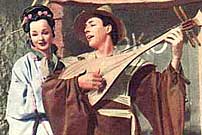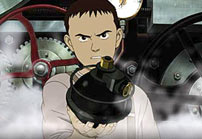Monday, March 28, 2005
Memoirs of a Geisha: Controversies

The summer that I spent in Japan, five years ago, was an invaluable experience, no detail of which I will ever forget. However, despite my wonderful host parents, teachers, and students, there were those moments when I was, briefly, put on the spot as an American…. when talking about Hiroshima, taking showers in the morning, and of course, Hollywood. I cannot count how many times I was asked, not in a hostile way, but in a curious and serious way, “Why do Americans think we all look alike?” “Why don’t you know the names of any Japanese actors?” “Don’t you know that the woman who plays Miss Saigon is Filipina?” etc, etc.
And so, it is with these voices in my mind that I have to approach the upcoming Memoirs of a Geisha film, slated for a December release. In a recent LA Times article, the director of the film, Rob Marshall, defended his casting of Chinese and other non-Japanese actors in critical roles, a position which has caused a flurry of letters to the editor, and online debates. With the film in post production and its release a long ways off, expect many more posts and articles on the subject on the Black Moon as the months go by. For now, however, I’ll weigh in on the casting controversy, to which even producer Steven Spielberg felt it necessary to respond.
After 150 years, it would really be nice if Americans finally got a realistic portrayal of Japan. Not a dubbed and edited cartoon, not a racist rip-off of a game show, not a legacy of war and imperialism, not yet another story about Japan told through Western eyes. Hollywood does indeed have a horrible legacy when it comes to relations with Japan, from wartime propaganda films, to generations of white actors with taped eyes, and more recently, modern “Japanexploitation” films where violence, sex, and more violence is the name of the game. We’re talking about a Hollywood that just a few years ago, made a piece of jingoistic bilge like Pearl Harbor, and then turned around and marketed an edited version back to the Japanese as a love story.
So yes, I would love to see an accurate, authentic film about 1930s Japan, maybe even one about geisha. I’d like to see it in Japanese with English subtitles, and I’d like to see it accurately reflect Japanese culture, aesthetics, history, values, and then some. I know it can be done, if people will it to be so…. see how anime in the West, in just a few years, has gone from cult-following to Academy Award-winning status. Even recent Japanese horror movie remakes, like The Grudge and The Ring 2, used the original Japanese directors. But can we expect such an ideal film as I described, from writers like Arthur Golden, and filmmakers Rob Marshall and Steven Spielberg? When we already know that Spielberg rejected the advice of Akira Kurosawa, to produce the film in Japanese with subtitles? Alas, dear readers, I suspect Hollywood has taken the wrong path, yet again. (posted by J.)
Sunday, March 27, 2005
Steamboy Anime in US Theaters

If you haven’t been living under a rock, then you’ve most likely heard of Akira, the mind-bending science fiction classic from manga artist turned anime director, Katsuhiro Otomo. First released in 1988, the Akira film immediately set new standards for animation with its amazingly detailed backgrounds and fierce action sequences of futuristic motorcycle gangs at war with themselves and the rest of society. Now Otomo is back with a vengeance with his latest release… Steamboy. The story is set in an alternative timeline, where Victorian England benefits from all sorts of newfangled technologies. Lead character, Ra Stim (Ray Steam), obtains a strange device brimming with enough energy to power an entire country. The central concern of the plot has to do with the mishandling and exploitation of science, but audiences will immediately be stunned by the opalescent and brilliant animation… a mix of traditional cel and computer generated imagery. It took ten years and $22 million dollars to make Steamboy, making it the most largest-scale Japanese animated film to date. You can see trailers and film clips of the movie at MovieWeb, including an interview with Katsuhiro Otomo on the animation process and an interview with Patrick Stewart on “the human element in Japanese animation.” (Stewart is the voice actor for a character in the dubbed western version). The anime is now playing in movie houses across the US, and in Los Angeles, people can see it at the Nuart Theater in Santa Monica. (posted by M.)
Sumo Tournament in Osaka

The spring Grand Sumo Tournament in Osaka Japan, has concluded with Asashoryu winning the coveted Emperor’s Cup, becoming Yokozuna or Grand Champion. On Saturday the Mongolian born Asashoryu conquered his opponent, Champion Kaio, in a teeth-clenching bout that was clinched when Asashoryu tossed his adversary from the ring using a classic arm throw. The match at the Osaka Municipal Gymnasium was attended by a crowd of thousands, which included visiting French President Jacques Chirac (a big fan of sumo). Sumo is an age old form of wrestling that originated as a ritual performance to Shinto gods. While it has become the national sport of Japan, it still carries with it many of the ceremonies associated with its past.
The rules of sumo are amazingly simple. During a basho, (a sumo tournament), wrestlers or rikishi (literally “strong men”), attempt to push, fling, or slap an opponent outside of the dohyo (the small ring within which the bout takes place). The rikishi who first leaves the ring or in any way touches the floor of the dohyo with anything but the soles of his feet… loses. The fights usually last only a few seconds but the pageant and tradition of it all is gripping. Once a wrestler reaches the rank of yokozuna, he cannot lose the title, however, as soon as his performance starts to weaken he is expected to retire. The most lasting image of sumo in the west is the physical appearance of rikishi, enormous men who train extensively and eat tremendous amounts of special foods in order to increase their body weight to unbelievable proportions. Sumo is gaining increasing international popularity, with sumo federations engaging in tournaments all around the world. Here in Los Angeles we have the California Sumo Association (CSA), which just completed its 5th Annual US Sumo Open at the Los Angeles Convention Center. CSA not only offers training and education to sumo athletes, but also promotes the sport through demonstrations and events while also supporting international efforts to make sumo an Olympic sport (posted by M.)
Thursday, March 24, 2005
Artists for Tsunami Relief
Wednesday, March 23, 2005
Los Angeles - Vintage Kimono Sale
The next Texuba spectacular will be held for one day only, on Sunday April 3, from 10 to 5 pm at the Holiday Inn, Gateway Ballroom, 19800 S. Vermont Ave, Torrance, CA 90502. Serious shoppers are advised to come early, and be ready to be amazed at the beautiful assortment of handmade, authentic Japanese textiles for sale. Newcomers will also be surprised, that the kimono can be found in a wide variety of sizes, for children, women, and men. Although sadly, Texuba only has these galas in New York, Los Angeles, and San Francisco, they are a must for serious kimono collectors, interior designers, anime cosplay fans… or anyone looking to add some authentic Japanese flare to their home décor. For those who enjoy sewing and home decorating, the variety of beautiful kimono remnants can be used to make clothing, pillows, wall hangings, or countless other lovely items for the home. For more information, please visit their website at texuba.com (posted by J.)
Tuesday, March 22, 2005
Sushi and Anime
On the Black Moon, therefore, you can expect a little bit of everything. We understand that there is tremendous interaction between Japan and the west, interaction that has been going on for hundreds of years, so we won’t be afraid to ponder, pontificate, question, support or malign, all the many issues that have and will come up from this continual exchange. As our blog sits on the Western side of the Pacific rim, we will also focus on issues in American popular culture, what’s going on in the Asian-American community…. But always with an eye for history, art, culture, and mutual understanding. So while I work on my grand opus, to prove how Sailor Moon was inspired by the psychedelic British film Wonderwall…. enjoy our occasional musings, attend some great events, and always, be ready to learn something new. (posted by J.)
Saturday, March 05, 2005
The Black Moon Blog

The Black Moon web log originates from the city of Los Angeles, California and promotes the understanding and appreciation of traditional Japanese culture, art, and animation. The Black Moon is based on a core philosophy, that actively seeking cultural exchange is the best way to tear down the walls of ignorance. We launched the Black Moon website as an anime fan-site back in 1997, and since that time have expanded it into the vast resource it is today. Our web log launched on March 5th, 2005. Our desire is to continually explore the many issues that the international English speaking audience might find enlightening, and to showcase Japanese-American culture both here in Los Angeles and across the United States... and most importantly... do it all with a flair for beauty and love of art.

